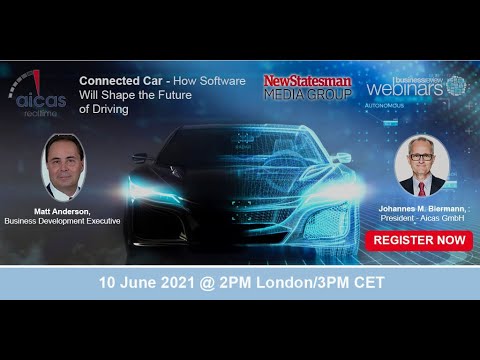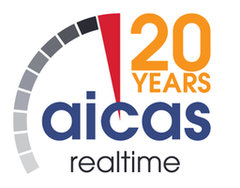Thought leadership
Sponsored by AICAS
Software Will Shape the Future of Driving
An emergency drill onboard AIDAsol cruise ship in 2019. Image: MikhailBerkut / Shutterstock.com
Vehicles have undergone a significant evolution in recent decades, transitioning from analogue to fully digital driving systems. For most consumers, the difference is only noticeable in terms of features and benefits: better gas mileage, onboard GPS, or digital displays in the car. For manufacturers, however, this transition has meant significant changes to how the systems are developed, deployed, maintained, and monetized.
What is going on in the global automotive industry right now could be compared to the development of the smartphone 15 years ago. In the connected transport space, we see the same revolution happening, getting more of the car as a digital device surrounded by an entire ecosystem. This opens new business models; OEMs and car manufacturers have to re-think their product development process concerning the most important aspect nowadays: software. And, of course, the data and security issues that come along with that.
The Software-Defined Vehicle
The automobile is one of the most complex consumer products on the market. By becoming a part of a larger IoT environment, vehicles are no longer only an assembly of hardware parts. In fact, they require sophisticated software to manage every aspect of the vehicle—from the internal workings including entertainment and user interfaces, to the external systems that rely on its data and security. This is why future vehicles will be software-defined.
Before the introduction of digital technologies to cars, busses and trucks, most consumers bought their cars based on features like brand, horsepower, fuel efficiency, price, and comfort, even color. But today’s car buyers are looking for a wider set of amenities and benefits that are powered by online services. Manufacturers keen to compete require a sophisticated software platform to manage every aspect of future vehicles. Such a software platform is used to innovate, develop, test, and deploy new features faster than traditional development.
Many believe that the future of transportation will be based on autonomous vehicles. Autonomous cars will rely on data and logic going into the vehicle’s board computer, being utilized within the car but also outside and remotely. According to the Intel CEO, an autonomous vehicle may create 40 terabytes of data for eight hours of driving, most of which will be processed inside the car. But how does one know which part of this data is needed for fleet management or future functionalities? Which new business models result from all this available information? How do vendors provide and update the logic of the different domain controllers, any of the ECUs or other critical embedded systems?
Advanced future software needs to do more than simply manage data; it needs to deliver unimpeded performance of critical systems while also being flexible enough to allow for future expansion. All of this needs to happen with the required security and increased safety for always online vehicles. That is where software development kits like aicas’ JamaicaVM and JamaicaCAR fit in. These SDKs are the GO_TO solution! These aicas tools development kits provide an ideal platform for developing, running and updating critical embedded systems.
Connected Car Business
By connecting a vehicle to the Internet using high-speed connections (5G and beyond), manufacturers can now start to offer Software-as-a-Service (SaaS) features, such as subscriptions to Internet-based services that are directly integrated with the vehicle. In other words, where software once helped manufacturers create features that differentiate their products, software services are now making all the difference.
A connected car is no longer simply an object to take passengers from point A to point B; it is now a service-delivery system, similar to smart TVs delivering hundreds of channels, in addition to Internet, and a variety of built-on subscription services. This has the potential to significantly grow each car’s life and lifetime value.
Connected cars come with an abundance of sensors, collecting a wide variety of data, such as road conditions, proximity to other vehicles, internal and external temperature, velocity, and so on. The on-board computing system will read the data and if needed, act - such as activating a break as a part of the lane-keeping assist system. The connection to the outside world happens via a telematics unit. These systems will become ever more important as the gateway into the vehicle. This valuable connection to the outside world will provide new opportunities. The use of data is already fueling new business models in fleet management, insurance and online sales of automakers like GM, Rivian and Tesla . But not only automotive OEMs are actively working on new business models for the edge.
Insurance companies are collecting a variety of data, such as speed, velocity, and braking data, with after-market add on systems. The data is then used by the insurance company to analyze and determine how safe (or unsafe) a driver is, by using machine learning. The insurer can then customize or modify the driver’s rates based on a more data-driven risk model personalized to the driver. The connected car represents an evolutionary step in a larger shift towards fully autonomous vehicles, a second wave of disruption, that will transform the activity of driving itself.
The big challenge for the automotive industry is to generate and respond to new unproven business models. Most will only be possible when data and its underlying logic become easily exchangeable. aicas’ Jamaica family of software products, with their highly flexible OTA capability and very broad support of APIs already provides 5 of the top 10 automotive OEMs with the required flexibility.
If you would like to get deeper in topics like how software is going to manage millions of data or six levels that define autonomous driving we recommend the recording of our webinar "How Software Will Shape the Future of Driving" with Matt Anderson, Business Development Executive and Johannes M. Biermann, President - aicas GmbH.
Ben Bouldin is Royal Caribbean’s vice president sales for Europe Middle East and Africa. Image: Royal Caribbean
Muster 2.0 removes friction on board
When looking at the new Muster 2.0 drill process in the context of Royal Caribbean’s digital transformation, it is a natural development for a company striving to reduce passenger friction on board.
“The innovative programme is the first of its kind and reimagines a process originally designed for larger groups of people into a faster, more personal approach that encourages higher levels of safety,” says Royal Caribbean’s vice president of sales Ben Bouldin for Europe Middle East and Africa.
The safety drill has always put a pause on the cruise experience
Over the last few years reducing friction has been the focus of Royal Caribbean’s digital department and the goal of the Royal app, which, among other features, allows guests to avoid queues by finding out information and booking dinner tables, activities, excursions and shows online.
In 2018, at the launch of Symphony of the Seas, Royal Caribbean’s senior vice president of digital Jay Schneider explained to Future Cruise that building guest products that “get people out of lines and let people enjoy their vacation first and foremost” has been one of his main missions.
Recently he said that: “Muster 2.0 represents a natural extension of our mission to improve our guests’ vacation experiences by removing points of friction.”
Ben Bouldin is Royal Caribbean’s vice president sales for Europe Middle East and Africa. Image: Royal Caribbean
Schneider and Nick Weir, the senior vice president of entertainment at Royal Caribbean were instrumental to the development of Muster 2.0. Weir is behind some of the most original and innovative entertainment experiences guests can have at sea and has successfully mixed and transitioned formats and blended technology into traditional structures, such as turning an on-board ice rink into laser tag, back again into an ice show with synchronised drones and moving image effects such as those that transform the ice into an emotive Arctic whale scene.
“The safety drill has always put a pause on the cruise experience, and I felt like it could be more efficient,” explains Nick. When he was a cruise director he explains how he was responsible for the welcome party as well as drill announcements which always brought a halt to the fun as guests were starting to enjoy themselves.
“I happened to be outside on one hot, sweaty day during the drill, and I thought why not put it all on a device so it can be done individually and monitored? Technology naturally played a big part, location services on smartphones is essential, and a big team at Royal Caribbean came together to make it happen.”
Muster 2.0 removes friction on board
When looking at the new Muster 2.0 drill process in the context of Royal Caribbean’s digital transformation, it is a natural development for a company striving to reduce passenger friction on board.
“The innovative programme is the first of its kind and reimagines a process originally designed for larger groups of people into a faster, more personal approach that encourages higher levels of safety,” says Royal Caribbean’s vice president of sales Ben Bouldin for Europe Middle East and Africa.
The safety drill has always put a pause on the cruise experience
Over the last few years reducing friction has been the focus of Royal Caribbean’s digital department and the goal of the Royal app, which, among other features, allows guests to avoid queues by finding out information and booking dinner tables, activities, excursions and shows online.
In 2018, at the launch of Symphony of the Seas, Royal Caribbean’s senior vice president of digital Jay Schneider explained to Future Cruise that building guest products that “get people out of lines and let people enjoy their vacation first and foremost” has been one of his main missions.
Recently he said that: “Muster 2.0 represents a natural extension of our mission to improve our guests’ vacation experiences by removing points of friction.”
Ben Bouldin is Royal Caribbean’s vice president sales for Europe Middle East and Africa. Image: Royal Caribbean
Schneider and Nick Weir, the senior vice president of entertainment at Royal Caribbean were instrumental to the development of Muster 2.0. Weir is behind some of the most original and innovative entertainment experiences guests can have at sea and has successfully mixed and transitioned formats and blended technology into traditional structures, such as turning an on-board ice rink into laser tag, back again into an ice show with synchronised drones and moving image effects such as those that transform the ice into an emotive Arctic whale scene.
“The safety drill has always put a pause on the cruise experience, and I felt like it could be more efficient,” explains Nick. When he was a cruise director he explains how he was responsible for the welcome party as well as drill announcements which always brought a halt to the fun as guests were starting to enjoy themselves.
“I happened to be outside on one hot, sweaty day during the drill, and I thought why not put it all on a device so it can be done individually and monitored? Technology naturally played a big part, location services on smartphones is essential, and a big team at Royal Caribbean came together to make it happen.”




